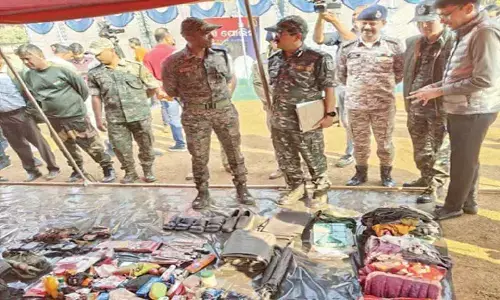NTR’s spl interest in housing for poor

Gaining the acceptance of new technologies by the allottees of housing continued to be a challenge. Paradoxically, the problem arose from civil engineers and the masons equally. There was a popular misconception that the thicker the wall is the more stronger it is! The strength of building materials was of no consequence in that belief system. On the other hand, the quality of cement was undergoing change and from 43 grade, the cement went up to 53 grade.
In spite of huge ad campaign from cement companies, the practices adopted by the field staff did not see significant changes. More and more training programmes for masons were rolled out by Nirmiti Kendras. We thought we needed to go beyond that. Some of our senior engineers under able the leadership of Chief Engineer Azad like Eswariah, Manik Reddy, Mrs Sharada, P Sriramulu, D Selvaraj, Ch Venkateswara Reddy, V Chandrasekhar Reddy and many more all collectively with their assistant engineers and work inspectors produced extraordinary results.
There was always the fear of false reporting of progress and wrong selection of allottees. I can vividly recall the pictures of some incomplete colonies like the colony in Govindraopet in Warangal district and Suraram Colony in Ranga Reddy district. Getting these colonies to a satisfactory stage of completion was no mean task due to both the aforementioned ills. Committed NGOs or individuals got involved in helping the allottees like the rickshaw-pullers colony in Nellimerla in Vizianagaram district, where Dr PDK Rao played an effective mentoring in this project. In every purchase of load of material, the colony body got involved and they only handled cash. This colony came up in an extraordinary manner. When such a significant contribution was being made by engineers of APSHCL, it beats my imagination that a government recently in Telangana decided to wind up this organisation!
In every colony, a ‘technology’ house was first completed. This came up from experience in ‘Prajala Vaddaku Palana’ programme launched by then CM of AP. To mention the background, a few words are necessary here. It so happened that former Advocate General mentioned to Dr NTR, the CM, about the contributions of Laurie Baker to housing in Kerala. Some photos were also shown to CM it seems. CM desired to know if there was any progress in that direction in AP, too. A 15- minute slot was provided for a review by CM on that subject.
Those were the days of over-head projector (OHP) and projection of transparencies. Different models that were being propagated in the three regions of the state were explained with the help of OHP. The meeting lasted for good 45 minutes and the CM was very pleased with our progress. Soon after that in a 7-acre piece of land on University of Hyderabad road, a Nirmithi Kendra was built. All the proto- types of the houses taken up in cyclone- prone areas, housing in hard soils, housing in black-cotton soils, housing with tiling roof on cement rafters, house roof with zero steel, housing with arch foundations etc were all built. On 15th August 1995, the Chief Minister was invited to inaugurate. The CM’s office gave thirty minutes at the venue for inauguration. Dr NT Rama Rao spent more than two hours and he was fascinated with the models of houses built with bricks and pre-fab bricks and aesthetics associated there.
Dr NTR was delighted to know the features of an earthquake-resistant house that was built on spherical cement balls. So also he spent a lot of time in the steel-less brick-on-edge roof house. He desired to get one built at his farm house. He then took a piece of paper and pen and drew a picture of a house and remarked “a poor man’s house need not be poor” where he meant that the lady of house must have space for kitchen and a toilet.
As a seasoned artiste, he produced some classics on silver screen, so this task was such an easy task for him. This special attention accorded by the CM gave the spur to our action at the launch of ‘Prajala Vadduku Palana’ that Dr NTR launched in Srikakulam in 1995. Our engineers got the foundation laid in the morning by local minister and got the house ready by evening for inauguration!
I can recall the shocked expressions on the face of CM and then Revenue and Finance Minister (Chandrababu Naidu). There was a quiet display of attractive features in technology adopted in housing programme. Same thing was done at Visakhapatnam and at Tirupati. A detailed presentation was made to the new Chief Minister on this aspect where exceeding the type design was dragging families to a debt- trap. Using fly-ash bricks and other pre-fab material prevented this occurrence and the period of construction was also under control.
The Government of Andhra Pradesh took up massive rural housing tapping funds available with commercial banks for priority sector lending as at least 50 per cent allocation of houses was made to Scheduled Castes. In all the tribal sub plan villages Scheduled Tribes were allotted housing.
Over a period of time as it happened by 1996, it was noticed that this 50 per cent coverage was not possible. Later, APSHCL approached commercial banks for differential rate of lending at simple 4 per cent rate of interest. The corporation was not focussed on recovery of loans and the defaults were growing. Even the attention to recovery was mitigated by the government, giving guarantee and repaying to commercial banks directly.
Though this programme fulfils an essential requirement as housing, it is commonplace knowledge that no direct additional revenue or earnings accrue to individual family. Very soon, the corporation set up HABTECH as a nodal agency to apply these technologies in buildings constructed by the state. For example, the artisan buildings at Shilparamam were taken up by Raghavaiah in deference to the orders of Chief Secretary Dr M S Rajaji.
There were housing programmes taken up for beedi workers, weavers, fishermen, leprosy-affected individuals and so on. In three years that I got to work here, there was so much of excitement and happiness getting into teams with dedicated services of so many colleagues who came on deputation from various departments. Many of them became my extended family members in later years.
I must recall the bitter experience of getting a transfer policy approved by the government and then undertaking action in right earnest. One after another, all MLAs were approaching for retention of their staff who were assisting in the constituency. Since the CM was a strict person, no one dared approach him in this regard. Details of housing taken up village-wise, scheme-wise and year-wise were carefully collated and submitted to the government. We were dismayed with the discovery of more SCs being allotted housing over the years compared to the SC population in 1991 census.




















